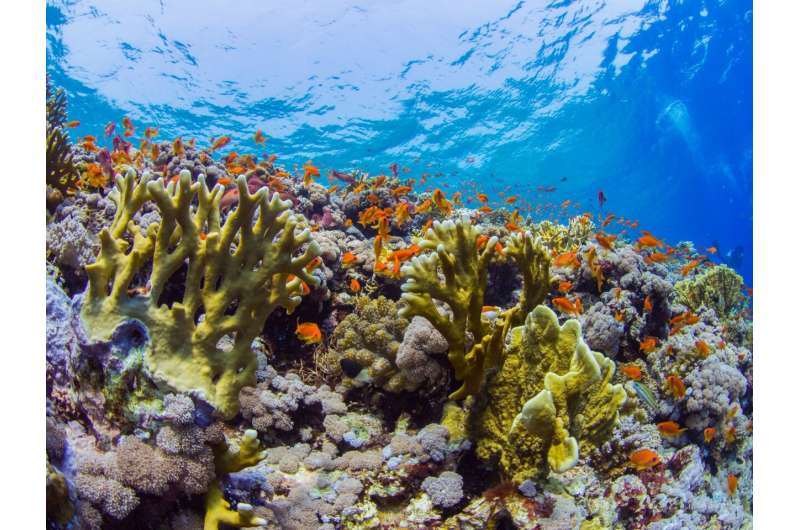This article has been reviewed according to Science X's editorial process and policies. Editors have highlighted the following attributes while ensuring the content's credibility:
fact-checked
peer-reviewed publication
trusted source
proofread
Largest-ever data set collection shows how coral reefs can survive climate change

Similar to the expeditions of a hundred or two hundred years ago, the Tara Pacific expedition lasted over two years. Its goal was to research the conditions for life and survival of corals. The ship crossed the entire Pacific Ocean, assembling the largest genetic inventory conducted in any marine system to date. The team's 70 scientists from eight countries took around 58,000 samples from the hundred coral reefs studied.
The first results of the analysis have now been published in Nature Communications. This largest-ever data set collection on coral reef ecosystems is freely available, and for years to come, will be the basis for elucidating the living conditions for corals and finding a way for them to survive climate change.
Important first results of the expedition show that global microbial biodiversity is much higher than previously thought. The impacts of the environment on evolutionary adaptation are species-specific, and important genes in corals are duplicated.
Global biodiversity ten times higher than assumed
Coral reefs are the most biologically diverse marine ecosystem on Earth. Although they cover only 0.16% of the world's oceans, they are home to about 35% of known marine species. Using a genetic marker-based data set, the researchers found that all of the globally estimated bacterial biodiversity is already contained in the microorganisms of coral reefs.
"We have been completely underestimating the global microbial biodiversity," says Christian Voolstra, professor of genetics of adaptation in aquatic systems at the University of Konstanz and scientific coordinator of the Tara Pacific expedition. He says the current estimate of biodiversity (approximately five million bacteria) is underestimated by about a factor of 10.
Impacts of the environment on evolutionary adaptation are species-specific
The 32 archipelagos studied serve as natural laboratories and provide a wide range of environmental conditions, allowing scientists to disentangle the relationships between environmental and genetic parameters across large spatial scales. This led to another important finding: The effects the environment has on evolutionary adaptation trajectories of corals are species-specific. To determine this, the researchers examined the telomeres, the ends of chromosomes that are the carriers of genetic information, for the first time.
In humans, the length of telomeres decreases during life; that is, with an increasing number of cell divisions, suggesting that biological age is closely linked to the length of telomeres. Researchers on the Tara Pacific expedition have now found that the telomeres in very stress-resistant corals are always the same length. "They apparently have a mechanism to preserve the lengths of their telomeres," Voolstra concludes.
In a more stress-sensitive coral species, which also has a shorter lifespan of about a hundred years, telomere length is aligned to environmental stress, such as temperature fluctuations. "A direct imprint of environmental stress levels on organismal resilience may even hold implications for human health," says Voolstra.
Important genes are duplicated
Research data from the Tara Pacific expedition brought to light that the long life of some coral species may have yet another reason: the duplication of certain genes. Many important genes are present multiple times in the genome. The researchers were able to determine this through sequencing of coral genomes employing a new high-resolution technique.
This technique, called long-read sequencing, makes it possible to not only determine the set of genes present, but also to look at their order in the genome. According to Voolstra, the pervasive presence of gene duplication could be a possible explanation for why corals can live for thousands of years despite being exposed, for instance, to extreme UV radiation in shallow waters.
The Tara Pacific expedition, named after the research vessel, will provide material for large-scale analyses of coral reef ecosystem diversity for years to come. What also makes the program unique is that samples were collected from multiple locations and over several years. The researchers examined the corals at each site in an identical manner, which makes the results fully comparable.
The entire data collection is freely accessible
All data sets are openly accessible and fully described with accompanying physical and chemical measurements to provide them as a scientific resource to all researchers.
"This is unique," Voolstra says. "It is the largest data set collection on coral reefs ever collected and it is completely open access." The aspiration is that this data collection will serve as a foundation and inventory to guide future study of coral reefs worldwide for many years.
More information: Serge Planes et al, Insights and achievements from the Tara Pacific expedition, Nature Communications (2023). DOI: 10.1038/s41467-023-38896-6
Journal information: Nature Communications
Provided by University of Konstanz




















